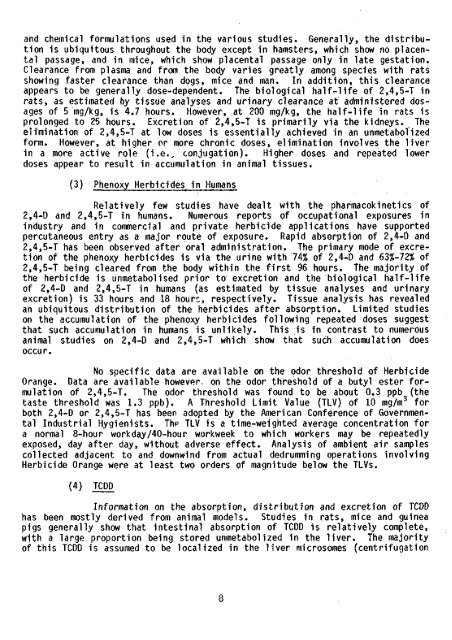Epidemiologic Investigation of Health Effects in Air Force Personnel ...
Epidemiologic Investigation of Health Effects in Air Force Personnel ...
Epidemiologic Investigation of Health Effects in Air Force Personnel ...
Create successful ePaper yourself
Turn your PDF publications into a flip-book with our unique Google optimized e-Paper software.
and chemical formulations used <strong>in</strong> the various studies. Generally, the distribution<br />
is ubiquitous throughout the body except <strong>in</strong> hamsters, which show no placental<br />
passage, and <strong>in</strong> mice, which show placental passage only <strong>in</strong> late gestation.<br />
Clearance from plasma and from the body varies greatly among species with rats<br />
show<strong>in</strong>g faster clearance than dogs, mice and man. In addition, this clearance<br />
appears to be generally dose-dependent. The biological half-life <strong>of</strong> 2,4,5-T <strong>in</strong><br />
rats, as estimated by tissue analyses and ur<strong>in</strong>ary clearance at adm<strong>in</strong>istered dosages<br />
<strong>of</strong> 5 mg/kg, is 4.7 hours. However, at 200 mg/kg, the half-life <strong>in</strong> rats is<br />
prolonged to 25 hours. Excretion <strong>of</strong> 2,4,5-T is primarily via the kidneys. The<br />
elim<strong>in</strong>ation <strong>of</strong> 2,4,5-T at low doses is essentially achieved <strong>in</strong> an unmetabolized<br />
form. However, at higher or more chronic doses, elim<strong>in</strong>ation <strong>in</strong>volves the liver<br />
<strong>in</strong> a more active role (i.e*, conjugation). Higher doses and repeated lower<br />
doses appear to result <strong>in</strong> accumulation <strong>in</strong> animal tissues.<br />
(3) Phenoxy Herbicides <strong>in</strong> Humans<br />
Relatively few studies have dealt with the pharmacok<strong>in</strong>etics <strong>of</strong><br />
2,4-D and 2,4,5-T <strong>in</strong> humans. Numerous reports <strong>of</strong> occupational exposures <strong>in</strong><br />
<strong>in</strong>dustry and <strong>in</strong> commercial and private herbicide applications have supported<br />
percutaneous entry as a major route <strong>of</strong> exposure. Rapid absorption <strong>of</strong> 2,4-D and<br />
2,4,5-T has been observed after oral adm<strong>in</strong>istration. The primary mode <strong>of</strong> excretion<br />
<strong>of</strong> the phenoxy herbicides is via the ur<strong>in</strong>e with 74% <strong>of</strong> 2,4-D and 63%-72% <strong>of</strong><br />
2,4,5-T be<strong>in</strong>g cleared from the body with<strong>in</strong> the first 96 hours. The majority <strong>of</strong><br />
the herbicide is unmetabolised prior to excretion and the biological half-life<br />
<strong>of</strong> 2,4-D and 2,4,5-T <strong>in</strong> humans (as estimated by tissue analyses and ur<strong>in</strong>ary<br />
excretion) is 33 hours and 18 hourc, respectively. Tissue analysis has revealed<br />
an ubiquitous distribution <strong>of</strong> the herbicides after absorption. Limited studies<br />
on the accumulation <strong>of</strong> the phenoxy herbicides follow<strong>in</strong>g repeated doses suggest<br />
that such accumulation <strong>in</strong> humans is unlikely. This is <strong>in</strong> contrast to numerous<br />
animal studies on 2,4-D and 2,4,5-T which show that such accumulation does<br />
occur.<br />
No specific data are available on the odor threshold <strong>of</strong> Herbicide<br />
Orange. Data are available however, on the odor threshold <strong>of</strong> a butyl ester formulation<br />
<strong>of</strong> 2,4,5-T. The odor threshold was found to be about 0.3 ppb (the<br />
taste threshold was 1.3 ppb). A Threshold Limit Value (TLV) <strong>of</strong> 10 mg/m 3 for<br />
both 2,4-D or 2,4,5-T has been adopted by the American Conference <strong>of</strong> Governmental<br />
Industrial Hygienists. Thp TLV is a time-weighted average concentration for<br />
a normal 8-hour workday/40-hour workweek to which workers may be repeatedly<br />
exposed, day after day, without adverse effect. Analysis <strong>of</strong> ambient air samples<br />
collected adjacent to and downw<strong>in</strong>d from actual dedrumm<strong>in</strong>g operations <strong>in</strong>volv<strong>in</strong>g<br />
Herbicide Orange were at least two orders <strong>of</strong> magnitude below the TLVs.<br />
(4) TCDD<br />
Information on the absorption, distribution and excretion <strong>of</strong> TCDD<br />
has been mostly derived from animal models. Studies <strong>in</strong> rats, mice and gu<strong>in</strong>ea<br />
pigs generally show that <strong>in</strong>test<strong>in</strong>al absorption <strong>of</strong> TCDD is relatively complete,<br />
with a large proportion be<strong>in</strong>g stored unmetabolized <strong>in</strong> the liver. The majority<br />
<strong>of</strong> this TCDD is assumed to be localized <strong>in</strong> the liver microsomes (centrifugation<br />
8
















